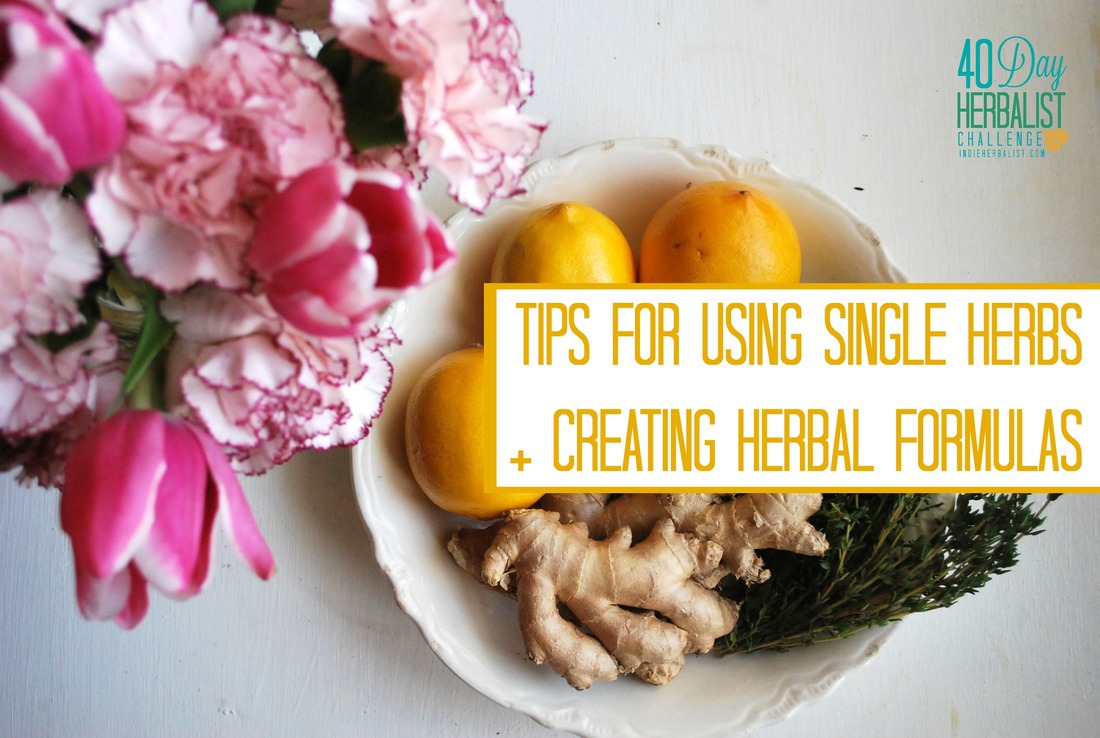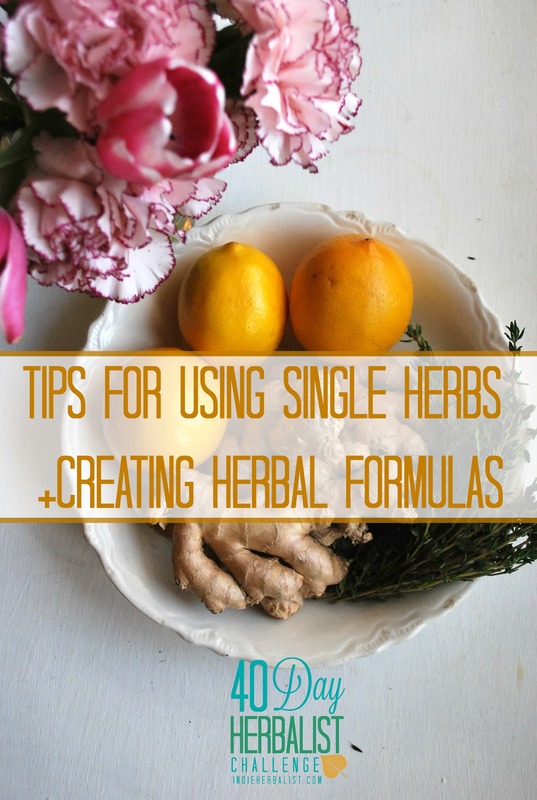Links contained in this post and elsewhere on my website may include affiliate links. When you make a purchase through these links, I earn a commission at no additional cost to you. I only link to products and services that I love - and that I think you will love, too!
Day 8 of the 40 Day Herbalist Challenge
Herbs can be used one at a time or blended together. The practice of using single herbs is sometimes called simpling, and blending herbs together is sometimes called formulation or compounding. Both practices can range along a spectrum from uncomplicated to complex, and herbalists eventually find a place on that spectrum where they are comfortable working and get good results. Let’s look at the strategies that can make each practice most effective.
Time needed: 20-30minutes
Tools needed: pen/pencils, notebook
One of the best things about simpling is how accessible it is. You don’t need to keep track of many ingredients and you can learn about herbs one at a time. Probably the most important thing to remember with simpling is that you will need to learn to work with each herb as an individual and be able to differentiate between the uses of similar plants.
For example, juniper berries and corn silk are both traditionally used as diuretics. Although corn silk has a reputation among herbalists for being soothing and moistening to the kidneys and urinary tract, juniper berries are not. They are more drying and irritating. So an herbalist might choose corn silk when there is a sensation of heat or burning, and turn to juniper berry when there is a sensation of coldness, heaviness, or excess mucus.
Simpling is also good to know in a pinch – maybe you find yourself in a situation where you don’t have a wide variety of herbs on hand. Knowing multiple uses for a single herb then becomes very useful.
Besides paying attention to the nature of the herb itself, you can also learn the “specifics” or specific indications of an herb. Although specifics is a very common concept in homeopathy, it’s less well known in herbalism. Essentially, this school of thought maintains that there are certain clues in the constitution, physical appearance, and emotional conduct of a person that will help you determine their best herbal match.
Juniper berries- Juniperus spp.
- Water retention in the lower body or in the upper arms and face
- Producing lots of clear urine
- Mucus in the urine
- Sand or gravel in the urine
Cornsilk- Zea mays
- Painful urination
- Bladder is irritated
- Urine is too alkaline
If specifics interest you, consider keeping good notes and record any interesting patterns that you observe through firsthand experience. The Earthwise Herbal volumes 1 and 2 by Matthew Wood, and his companion volume The Earthwise Herbal Repertory are my favorite resources for learning herbal specifics.
Blending
Herbal blends are also called formulas and compounds. Think of an artist’s palette. When combining colors, you make very intentional choices- otherwise your colors are muddled and indistinct. It’s the same with herbs. It’s tempting to blend as many herbs as possible, but you will often find that being more targeted will help you get better, clearer results.
There are two main approaches that you will likely see when it comes to blending herbs. Some herbalists prefer to focus on a specific body system (say, kidney support or respiratory health). Other herbalists select a few simples that match a person and combine the simples to create a custom blend – so the blend might have an herb for heart support, an herb to support the kidneys or urinary tract, and an nervine to support mood.
Both ways work.
Here’s an example for a blend created with the whole individual in mind. Let’s say you have a chronic heart condition that causes fluid buildup in your body and you also feel really crummy emotionally as a result. Perhaps you choose hawthorn (a heart supportive herb), juniper (to support the kidneys and fluid levels), and rose (for it’s uplifting nature) to create your personal formula. By supporting all three systems within your unique situation, you can help your body align itself in a more balanced way.
But perhaps another herbalist in the same situation would prefer to focus solely on the body system they perceive to be the core of their imbalance – the heart and circulation- with a goal of supporting that system. They may choose hawthorn and cayenne as heart tonics, then add ginkgo for circulation. Would this approach also work? Probably so! Hawthorn, although not specifically a diuretic, does have a reputation for assisting fluid balance when there is a heart related problem, and also has gentle nervine properties that support mood. Cayenne is a diffusive that helps the body balance circulation, thus balancing and removing excess stress from the heart.
Another way to decide what herbs to include in a blend focuses on dividing herbs into different categories within the blend. So you might choose one or two main herbs, then select a few assisting herbs with similar uses to round out or temper the actions of the main herbs, and maybe even include a “synergist” or “harmonizer” that helps to pull the blend together.
To use the example of juniper berry and cornsilk again, by combining the two they can moderate the action of the other. So cornsilk might be added to a blend that contains juniper berries to tone down their potentially irritating nature.
When you are ready to venture into blending herbs, here are a few things to keep in mind.
Keep it simple
More is not necessarily better- stick to a few herbs at a time, especially at first.
Stay focused
Whether you choose the focus as the individual, a body system, or an imbalance- having a focus is key.
Consider herbal qualities
Sometimes these are lumped in with herbal actions, but they are technically characteristics of the herbs themselves. Also sometimes called energetics, these are words used to describe the temperature and characteristics of the herb – whether it is warming, diffusive, moistening, cooling, or drying – and these can be used to help you hone in on which of two herbs might be better in your blend.
Contemplate specifics
if you like, you can also keep specifics in mind while choosing herbs for your blend by choosing a main herb that you think we will be the best match and modifying your selection with other herbs.
Your Mission
Research a few herbal formulas designed by well known herbalists and deconstruct them by looking up the actions and purposes for each herb. Herbal products by companies like Gaia Herbs, Herb Pharm, and Herbs Etc are excellent places to explore different blends and find one that looks interesting.
More Fun!
|
Herbal Medicine from the Heart of the Earth by Sharol Tilgner contains many formulas and their rationale to help you get started.
|
Agatha is the author of the popular new herbal recipe book, Adaptogens: Your Guide to Radiant Health!
|


